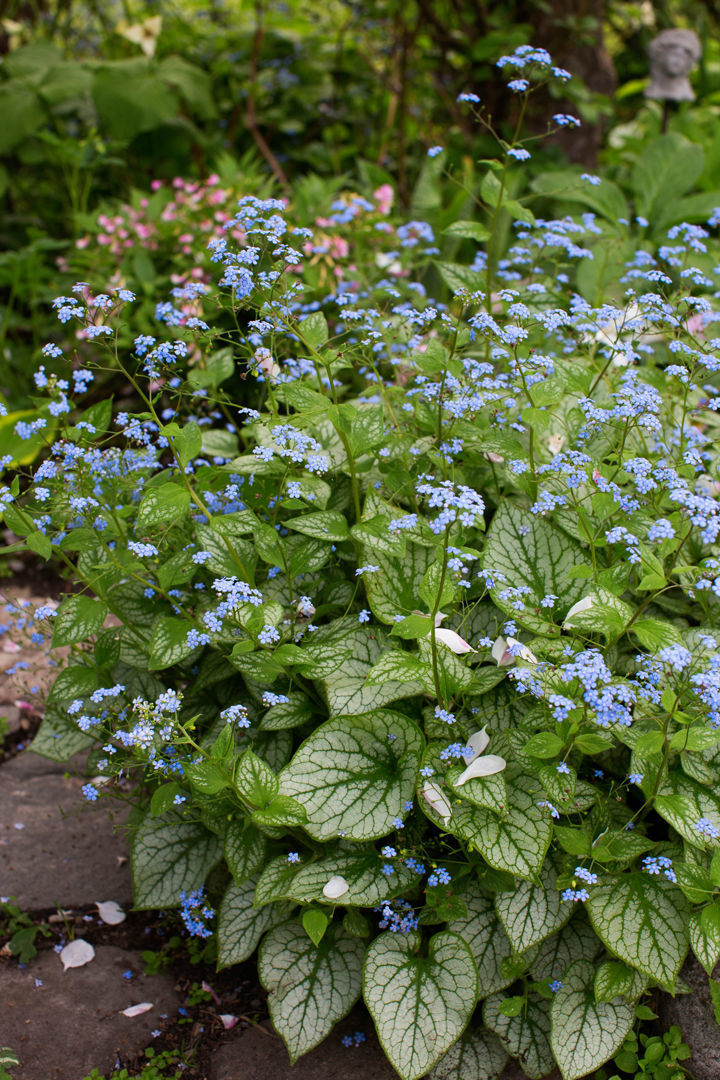
What: Brunnera is a slowly spreading, rhizomatous perennial, native to woodland areas. It’s prized for its sprays of spring flowers and its heart-shaped leaves. Short in stature, this plant is often used in masses or as a billowy ground cover.
Season: Flowers appear in early to mid-spring and can last through early summer. Foliage is evergreen in warm zones.
Size: 1 to 2 feet tall and 2 to 3 feet wide
Conditions: Partial to full shade; fertile, moist, well-drained soil
Propagation: Divide in fall; take root cuttings in winter.
Pests: Nematodes can cause superficial damage.
Good ol’ brunnera, with its cheery forget-me-not–like flowers, is experiencing a renaissance, of sorts—captivating gardeners in recent years with a bevy of new varieties that have incredibly colorful foliage. I honestly could be happy with the month or two of pretty blue flowers in spring and just let the standard green foliage fade into the background for the rest of summer. As it turns out, though, I can have my cake and eat it, too, due to some variegated selections that look fabulous after the flowers pass.

You’ll find brunneras (Brunnera macrophylla and cvs., USDA Hardiness Zones 3–7) at the nursery under a lot of different names, including Siberian bugloss, heartleaf brunnera, and false forget-me-not—the latter of which I prefer as it’s a nod to the true forget-me-not (Myosotis spp. and cvs., Zones 4–9), which brunnera’s flowers resemble. Beginning in early spring, sprays of dainty flowers unfurl above the brunnera plants for a month or more. The mostly azure blooms are an essential sign of spring for me, possessing just the right amount of whimsy to shake off the late-winter blues.
Brunnera’s bold, heart-shaped leaves, reaching up to 6 inches across, are somewhat reminiscent of hosta (Hosta spp. and cvs., Zones 3–9) foliage, but brunnera leaves have a rough, hairy texture. The leaves are often erroneously described as “fuzzy,” which, I guess, is a creative way of making the scratchy surface sound cuddly. Like hostas, brunneras form tidy clumps that are perfect for massing. The long-stalked leaves reach their full size only after the flowers, which are borne on separate leafy stems, have faded. Variegation has updated this old-fashioned perennial, giving brunnera a fresh new attitude. I’m particularly taken with the silvery selections—there’s something both elegant and exotic about their luminous leaves—but I’ve found quite a few favorites, thanks to this trial.
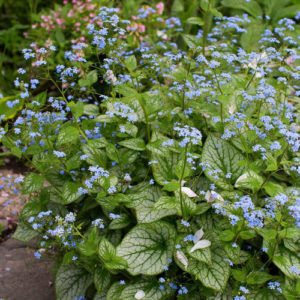
I was dumbstruck the first time that I encountered ‘Jack Frost’. Never had I expected to see such a wholly silver brunnera (‘Jack Frost’ is a sport of ‘Langtrees’, which features lightly silver-spotted leaves). Sure, ‘Langtrees’ is handsome, but this new silvery concoction was something special. Its large shimmering leaves are etched with green veins and borders, creating an intricate filigree pattern on the gleaming surface; you can almost see the blue flowers reflected in the fulgent leaves. I grow ‘Jack Frost’ to great effect with Japanese painted fern (Athyrium niponicum var. pictum and cvs., Zones 5–8) and ‘Obsidian’ heuchera (Heuchera ‘Obsidian’, Zones 4–9), and what a gorgeous trio they make.
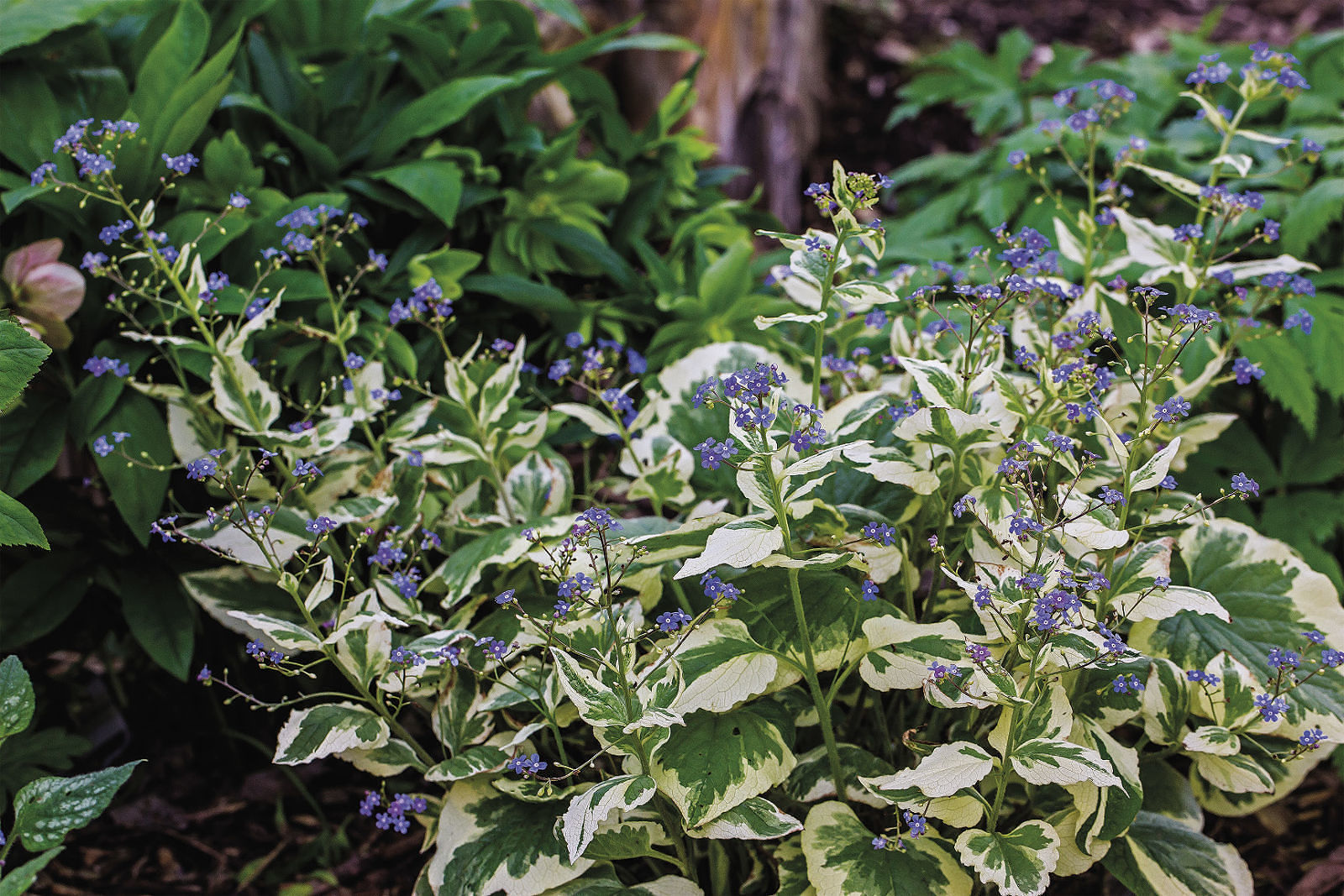
The foliage of ‘Dawson’s White’ possesses a romantic charm unlike any other cultivar. Generous creamy white borders surround grayish green centers—a beautiful combination that enlivens any shady place. The blue flowers really pop against the white margins and are especially stunning when the leaves are more white than green. ‘Dawson’s White’ is not a fan of drought conditions, and as you can imagine, the delicate white areas easily burn in too much sun or heat. ‘Dawson’s White’ masquerades as ‘Variegata’ in the gardening world; we tested both, and they proved to be the same plant. Reversions are common; in fact, we probably spent more time removing green leaves from ‘Dawson’s White’ than from any other cultivar. I didn’t mind because having this elegant plant in the garden is worth the small effort.
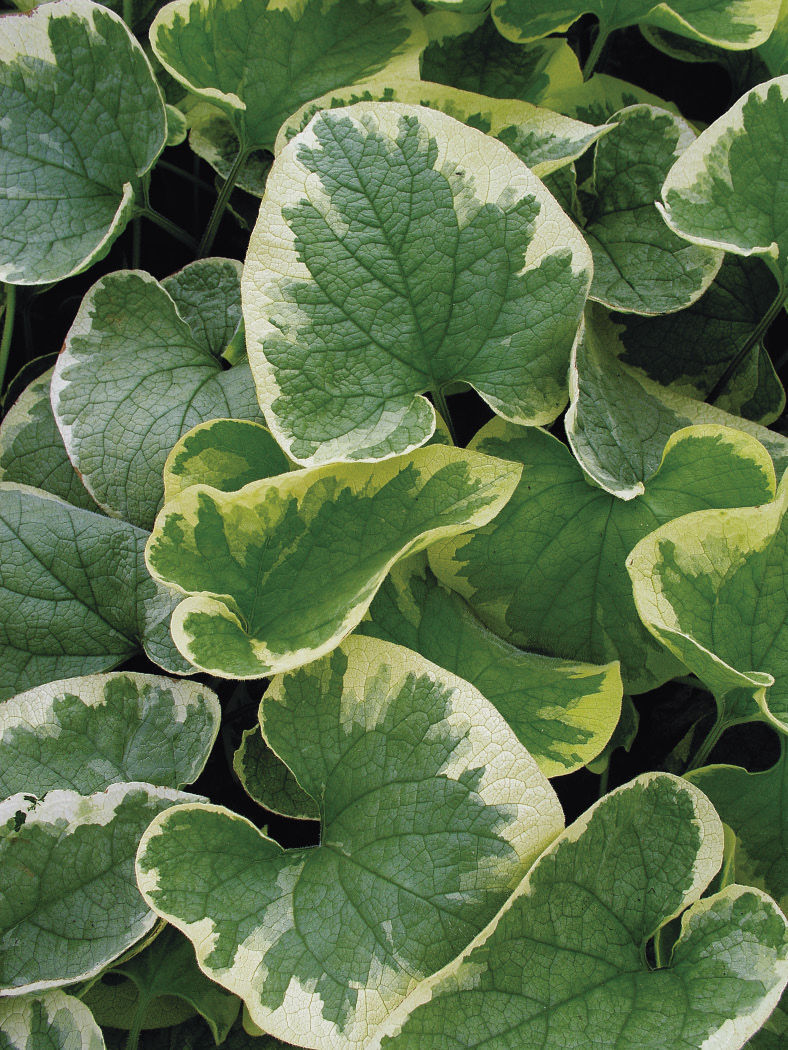
At a quick glance, ‘Hadspen Cream’ might look an awful lot like ‘Dawson’s White’, but if you look closer, you’ll notice that its margins are creamy yellow. During the summer, the leaves can look nearly white at times, so the confusion is understandable. Don’t put ‘Hadspen Cream’ in full sun, where its leaves will burn; it’s perfect in a moist woodland garden as an accent or when planted en masse. Its light blue flowers are a smidgen larger than most other cultivars and beautifully complement its soft yellow leaves. ‘Hadspen Cream’ planted with yellow-flowered ‘Golden Sunrise’ hellebore (Helleborus ‘Golden Sunrise’, Zones 4–9) provides a delightful color echo, while the timeless combination of their blue and yellow flowers can be enjoyed for weeks.
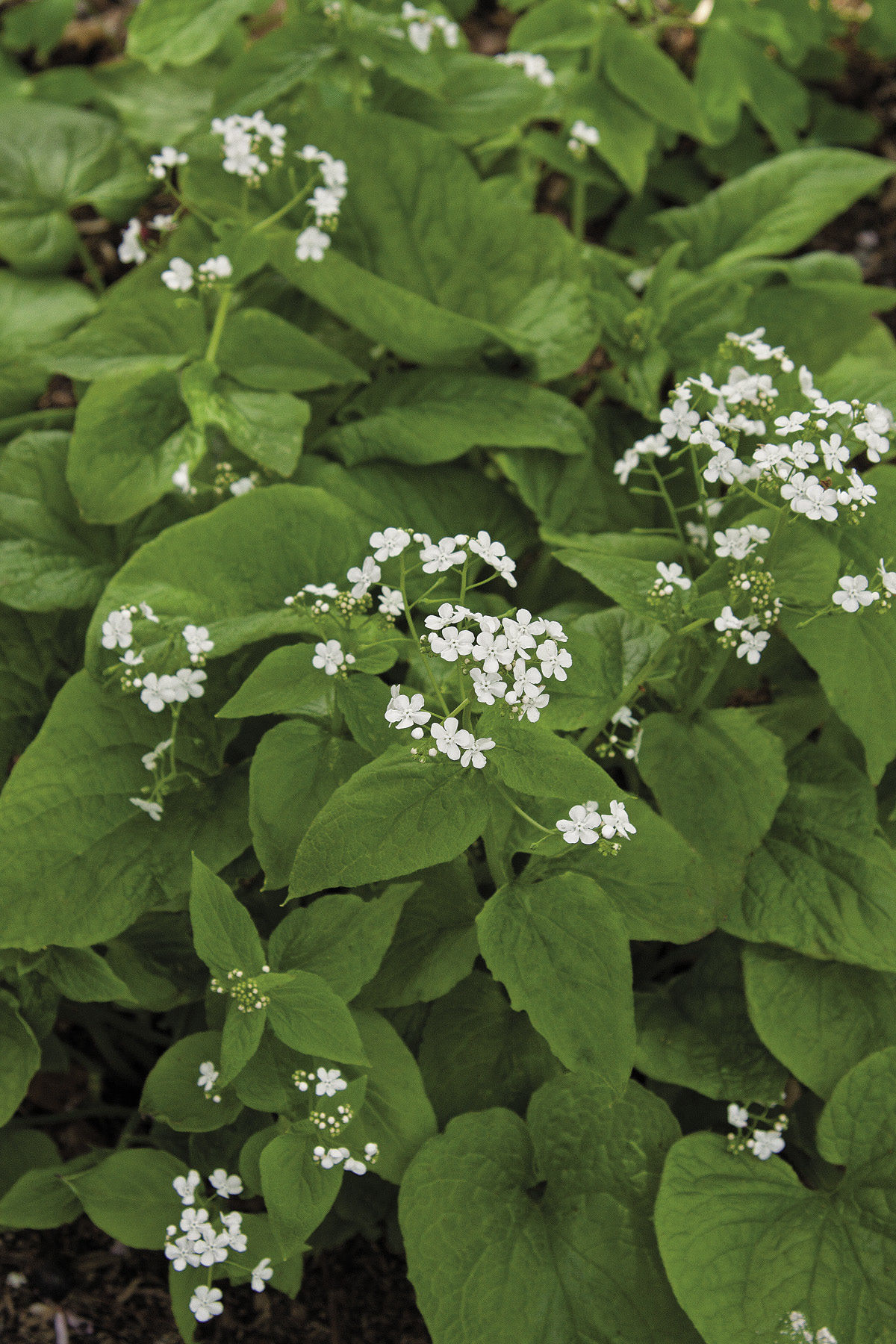
When not in bloom, green-leaved ‘Betty Bowring’ looks pretty much like the species. But in early spring, a profusion of white flowers marks the difference. As much as I love the blue of forget-me-nots and many brunneras, there is something beguiling about ‘Betty Bowring’. The pure white blossoms glow in the shade, creating a clean, refined display for many weeks. Like most cultivars, the plant remains tidy and attractive for the remainder of the summer. For a sophisticated look, pair ‘Betty Bowring’ with a white-striped plant, such as variegated Jacob’s ladder (Polemonium reptans ‘Stairway to Heaven’, Zones 3–8) or variegated fairy bells (Disporum sessile ‘Variegatum’, Zones 4–9).
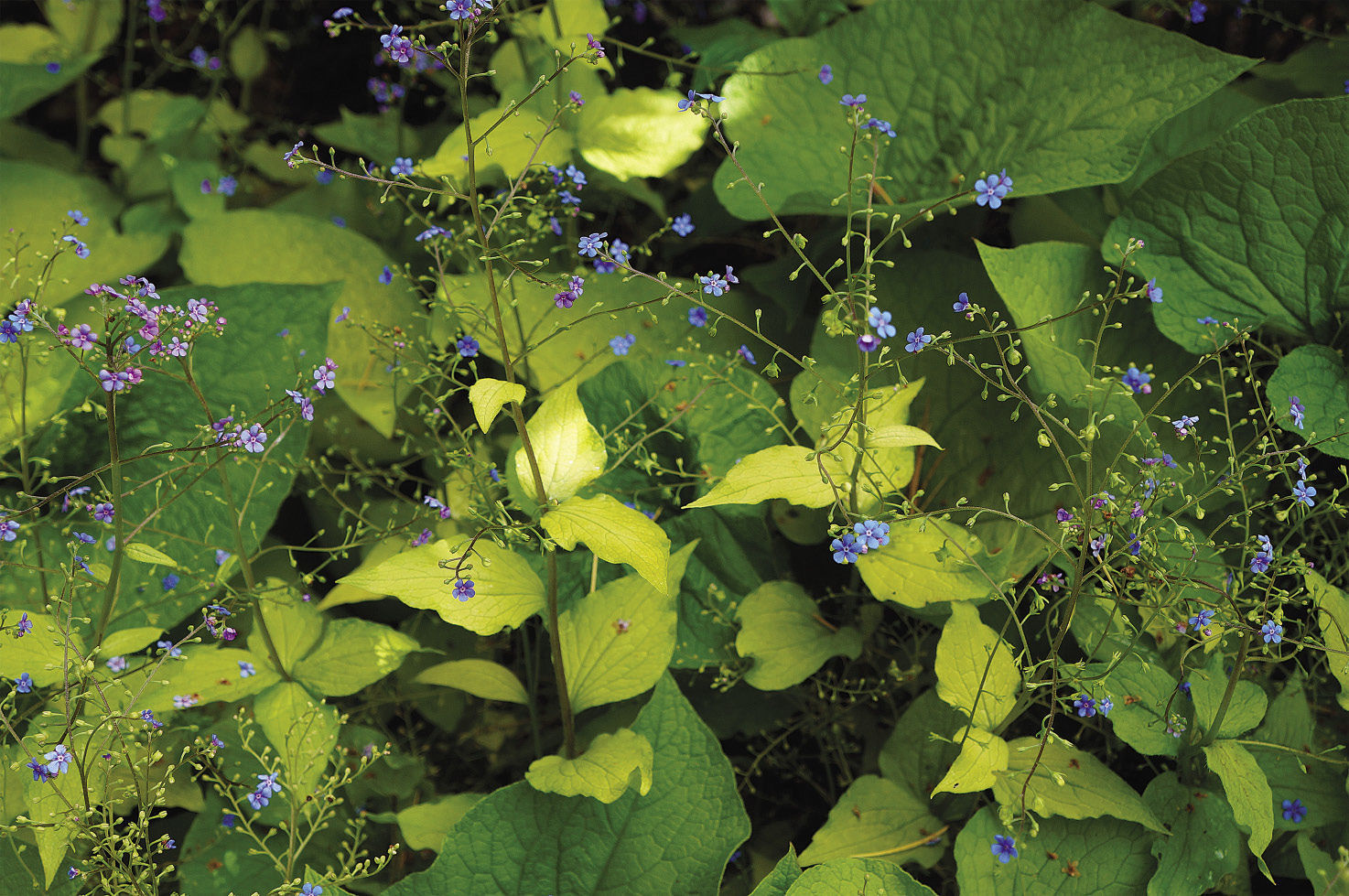
I was impressed from the start by the vigor of ‘Spring Yellow’, although its almost garish yellow leaf color didn’t excite me. I then discovered ‘Diane’s Gold’, which has a similar vigor but a tamer foliage color than ‘Spring Yellow’—and that clicked with me. The early leaves of ‘Diane’s Gold’ are golden-hued, changing to chartreuse for much of summer. The foliage is quite pretty in the shade, where the leaves hold their color the best; in too much sun, the leaves turn a whitish gold, which looks more sickly than interesting. ‘Diane’s Gold’ does not bloom as prolifically as most cultivars, but the combination of sky blue and golden chartreuse is dazzling, nonetheless.
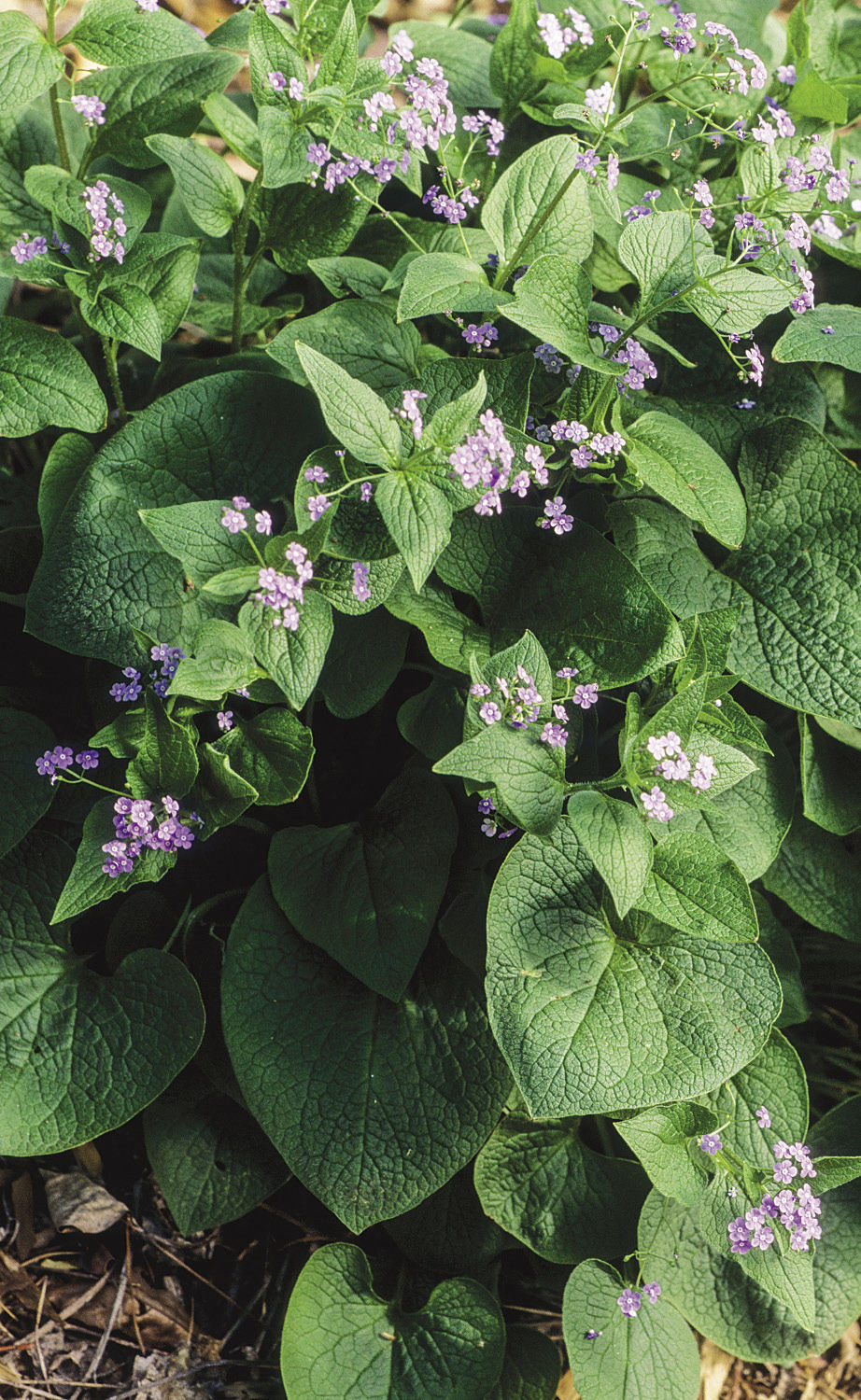
Next to all these variegated selections, it can be easy to overlook the simplicity and beauty of the species: standard brunnera. Its leaves are bold and handsome but solid green. With this plant, it’s all about the sprays of tiny blue flowers floating above robust clumps, which, admittedly, are understated without the blossoms. Standard brunnera’s reliability and trouble-free nature—it’s culturally not as temperamental as some variegated selections—appeal to gardeners who want a dependable ground cover in the shade garden. After its flowers have faded, standard brunnera is a great companion for more vibrantly colored plants, such as ‘Gold Heart’ bleeding heart (Dicentra spectabilis ‘Gold Heart’, Zones 3–9) and ‘Diana Clare’ lungwort (Pulmonaria longifolia ‘Diana Clare’, Zones 3–8).
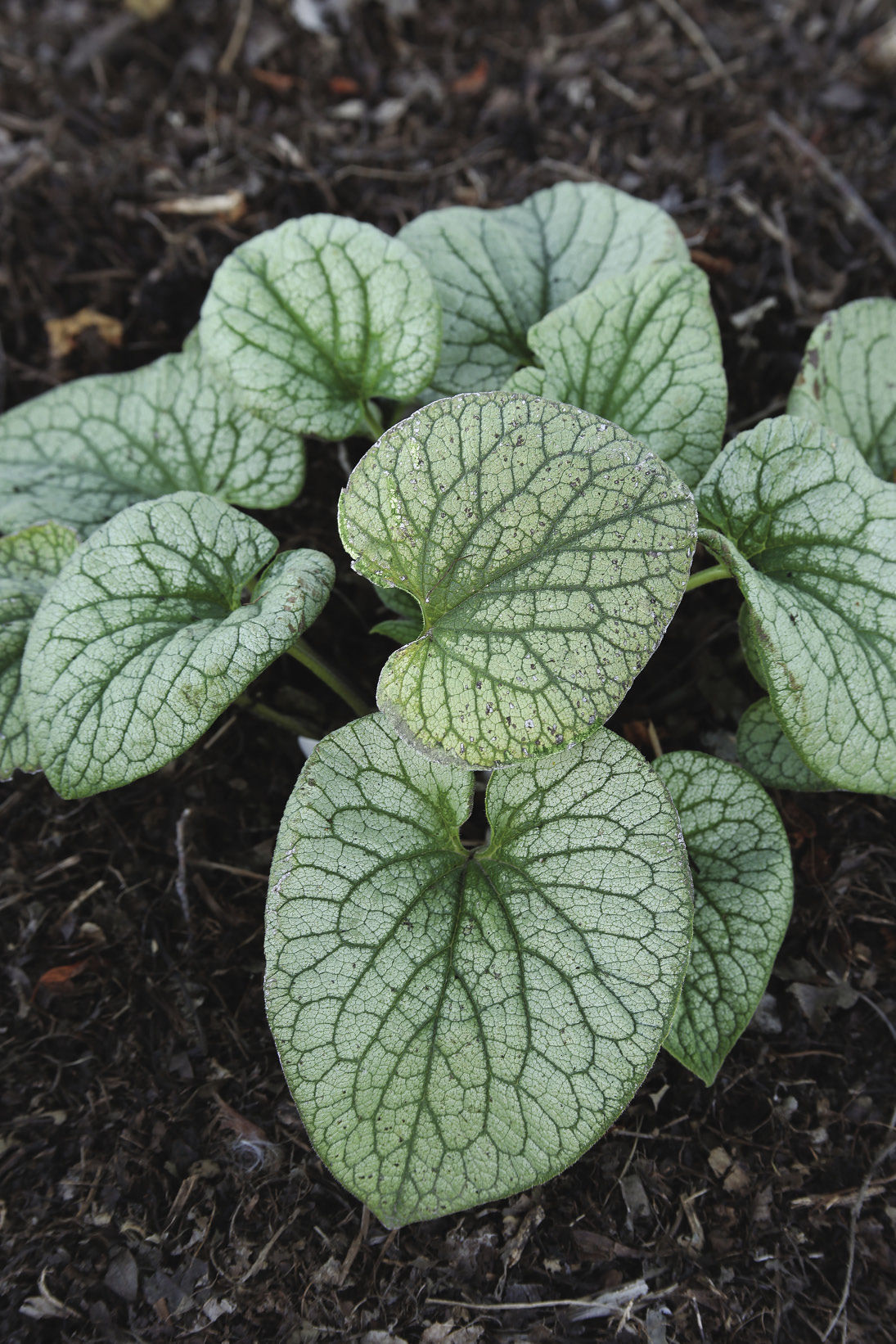
With a name like ‘Alexander’s Great’, it probably won’t be surprising that size is what sets this brunnera apart. ‘Alexander’s Great’ superficially resembles ‘Jack Frost’, with similarly striking green-etched silver leaves. The difference is that ‘Alexander’s Great’ is touted to have supersize leaves by comparison. I’ve only evaluated ‘Alexander’s Great’ for one season, so I haven’t seen its ultimate size yet, but so far, everything is pointing to its being bigger. Promotional materials show Alexander Zukeivich, the Belarusian originator of this plant, beside his creation, and each leaf looks at least a foot across. Where I’m confused is that the size of the plant in promotional materials is cited as 15 inches tall and 28 inches wide, which is not even as big as ‘Jack Frost’ in our trials. Clearly, I’m not the only one who has to grow ‘Alexander’s Great’ a while longer to discover its full potential.
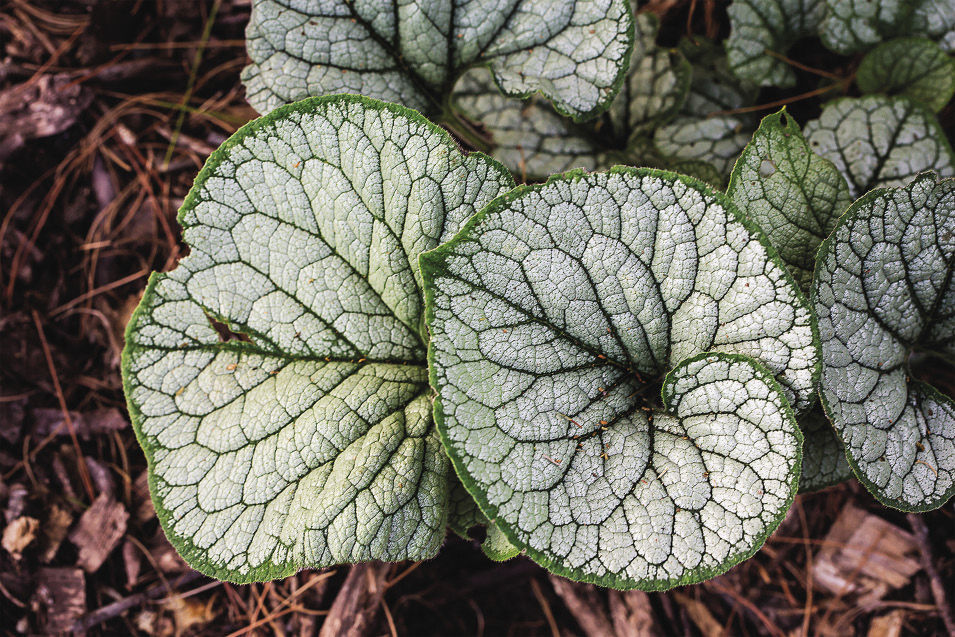
‘Sea Heart’ is another new selection with sparkling silver leaves overlaid with very dark green markings. While seemingly a lookalike of ‘Jack Frost’, as well, its claim to fame—aside from the irrepressibly bright leaves—is a greater tolerance for heat and humidity. We haven’t had an opportunity to fully test this claim because 2014 was a pleasantly mild summer for us; however, one of our plants received more afternoon sun than the others yet didn’t skip a beat. In early reports, the hairy, thick leaves appear to be less affected by foliar nematodes, too. In spring, the effervescence of the diminutive pale blue and lavender flowers is wonderfully juxtaposed against the metallic leaves. In its first year in our gardens, ‘Sea Heart’ grew to 12 inches tall and 24 inches wide—that’s already as big as expected at maturity. If you’ve struggled with brunneras in high heat and humidity, then ‘Sea Heart’ is the one to try.
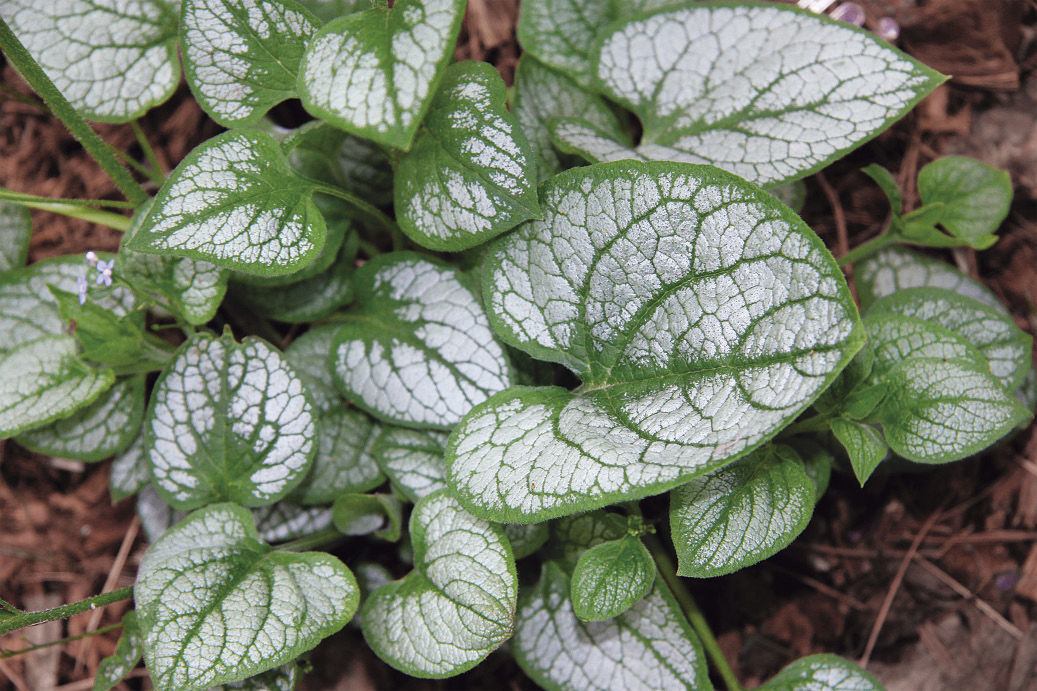
I was eager to grow ‘Silver Heart’ because I hadn’t had the best of luck with ‘Looking Glass’, which I’ve seen growing brilliantly in other places. The two are similar in appearance, but ‘Silver Heart’ has demonstrated improved resistance to heat and humidity in East Coast trials. And like ‘Looking Glass’, ‘Silver Heart’ is crazy beautiful. The frosted silver leaves practically glow in the shady garden; the green veins and edges are less prominent, allowing the silver to shine all the more. Dark blue flowers are a striking foil to the luminous leaves in springtime. In the first year in our gardens, the plants were 11 inches tall and 23 inches wide—just an inch off their anticipated full size. ‘Silver Heart’ pairs elegance and toughness in the same plant; its leaves look as delicate as a butterfly’s wing but are actually tough as nails.
Everything you should know about brunneras
Having lost my share of brunneras, I would not say that they are a cinch to grow. But if you give them what they want—a shady site with moist but not soggy soil—they will grow happily. Some reference books state that they will grow well in dry shade, but I’ve found that a consistently moist soil is essential for them to flourish, especially if the plants receive sunlight during the day.
If at first you don’t succeed, try again
Although ‘Betty Bowring’, ‘Dawson’s White’, ‘Hadspen Cream’, and ‘Jack Frost’ received high ratings in our trial, their journey to the top wasn’t without hiccups. We had to try and try—and try again—to get these plants established. I attribute this to issues with our site (at times too sunny, too wet, or too dry) rather than deficiencies in the plants. The third planting was often the charm.
Pruning is essential for good looks and health
Unsightly foliage, whether damaged from sun, drought, or pests, should be promptly removed. And severely damaged plants can be completely cut back to rejuvenate their health and appearance. Afterward, keep plants watered for several weeks while they recover.
Silver leaves hold up best to hot and humid conditions
Brunneras can suffer stress from heat and humidity, especially in areas at the warm end of their hardiness range; silver-leaved cultivars, such as ‘Jack Frost’, ‘King’s Ransom’, ‘Langtrees’, ‘Looking Glass’, ‘Sea Heart’, and ‘Silver Heart’, tough it out better than those with leaves of a different color.
Deadhead or else
Removing spent flower heads is vital to keeping plants tidy and healthy; it also reduces reseeding, which can be prolific in moist sites. Seedlings tend to arise close to the parents and aren’t considered invasive; variegated forms often produce green seedlings. Variegated cultivars periodically throw up green-leaved reversions, too, which should be cut out when they appear so that they don’t overwhelm the desired plant.
Too much sun will lead to scorching
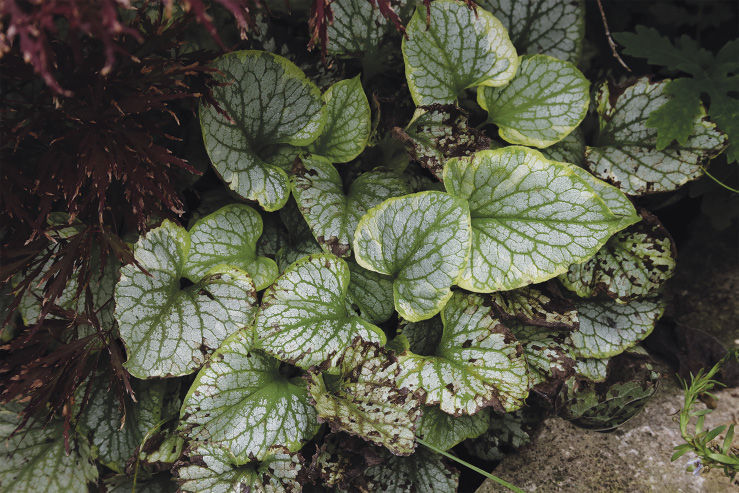
The creaminess of ‘Dawson’s White’ and ‘Hadspen Cream’ is enhanced by a bit of morning sun. But beware of hot, sunny locations, which will easily scorch these beauties.
A few pests can cause some damage
Brunneras are tough, fairly trouble-free plants, but you might occasionally see leaf damage from slugs, nematodes, and rabbits. These issues are, luckily, more cosmetic than a true health concern. Deer seem to ignore these plants.
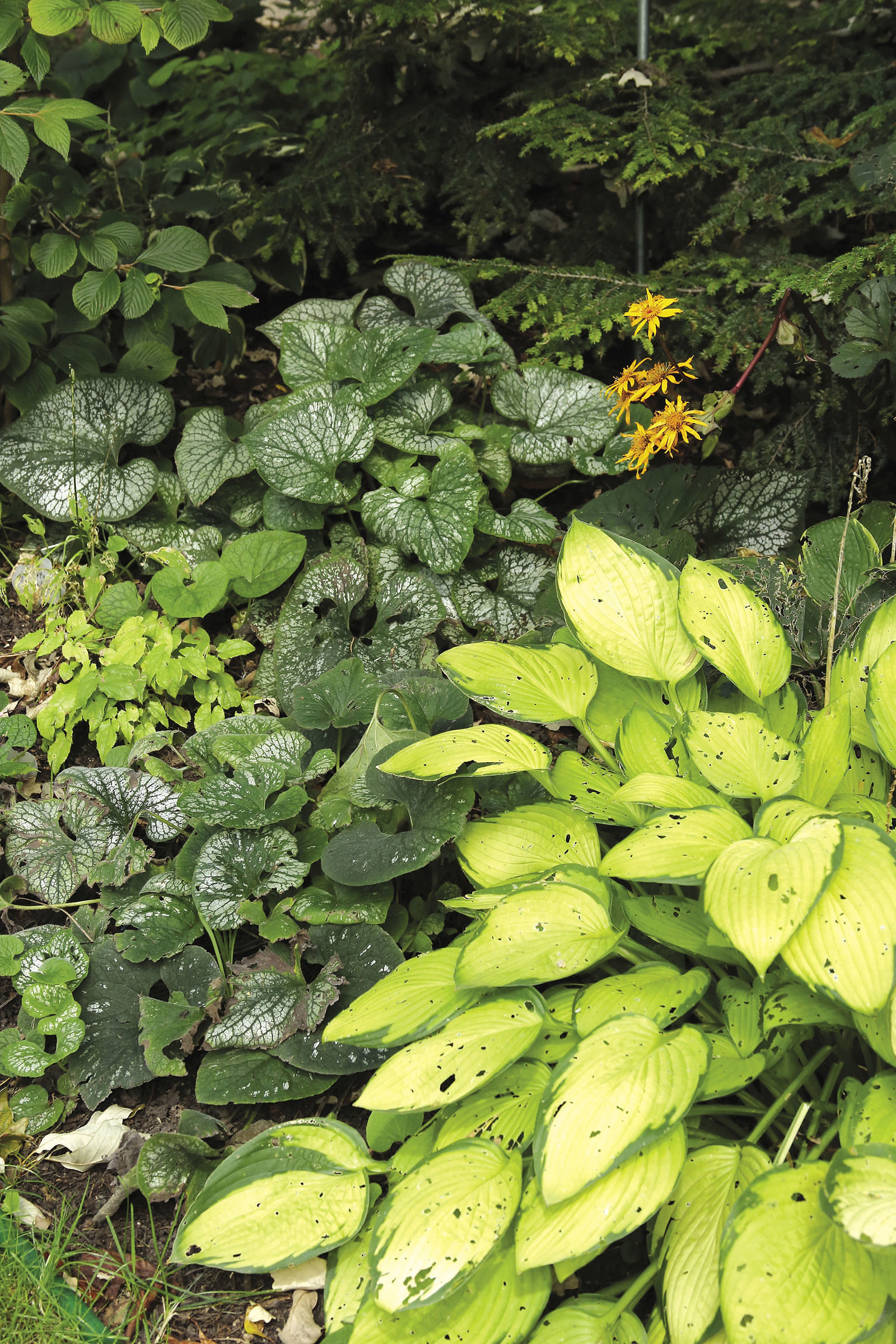
|
Ratings ★★★★ Excellent ★★★ Good ★★ Fair ★ Poor |
Trial Parameters How long: A minimum of four years Zone: 5b Conditions: Partial shade; moist, well-drained soil Care: Minimal, allowing plants to thrive or fail under natural conditions Observations: Ornamental traits; growth and adaptation to environmental and soil conditions; disease or pest problems; plant injury or winter losses |
| Overall rating | Name | Height | Width | Leaf color | Flower color | Bloom period | Flower production |
| ★ ★ ★ | Brunnera macrophylla | 18 inches | 36 inches | Green | Blue | Midspring to late spring | Heavy |
| ★ ★ ★ ★ | B. macrophylla ‘Betty Bowring’ | 19 inches | 42 inches | Green | White | Midspring to early summer | Heavy |
| ★ ★ ★ ★ | B. macrophylla ‘Dawson’s White’ | 16 inches | 33 inches | Green; creamy white margins | Blue | Midspring to late spring | Heavy |
| ★ ★ ★ | B. macrophylla ‘Diane’s Gold’ | 10 inches | 17 inches | Golden yellow-green | Blue | Early spring to late spring | Moderate |
| ★ | B. macrophylla ‘Emerald Mist’ | 6 inches | 10 inches | Dark green; silver spots | Blue | Late spring | Low |
| ★ ★ ★ ★ | B. macrophylla ‘Hadspen Cream’ | 15 inches | 28 inches | Green; creamy yellow margins | Light blue | Midspring to early summer | Heavy |
| ★ ★ ★ ★ | B. macrophylla ‘Jack Frost’ | 17 inches | 34 inches | Silver; green veins | Blue | Midspring to early summer | Heavy |
| ★ ★ ★ | B. macrophylla ‘King’s Ransom’ | 14 inches | 27 inches | Silver; yellow margins | Blue | Midspring to late spring | Heavy |
| ★ | B. macrophylla ‘Langtrees’ | 14 inches | 36 inches | Green; silver spots | Blue | Midspring to late spring | Low |
| ★ ★ | B. macrophylla ‘Looking Glass’ | 8 inches | 12 inches | Silver; green veins | Blue | Midspring to late spring | Moderate |
| ★ ★ ★ | B. macrophylla ‘Mr. Morse’ | 12 inches | 28 inches | Silver; green veins | White | Midspring to late spring | Moderate |
| ★ ★ ★ | B. macrophylla ‘Silver Wings’ | 18 inches | 36 inches | Light green; silver spots | Light blue | Late spring to early summer | Heavy |
| ★ ★ ★ | B. macrophylla ‘Spring Yellow’ | 18 inches | 32 inches | Yellow | Light blue | Midspring to late spring | Heavy |
Richard Hawke is the plant evaluation manager at the Chicago Botanic Garden in Glencoe, Illinois.
Photos, except where noted: millettephotomedia.com, courtesy of Richard Hawke, Pernilla Bergdahl/gapphotos.com, Doreen Wynja, Jerry Pavia, Danielle Sherry
SOURCES
The following mail-order plant sellers offer many of the brunneras featured:
Digging Dog Nursery, Albion, Calif.; 707-937-1130; diggingdog.com
Forestfarm, Williams, Ore.; 541-846-7269; forestfarm.com
Variegated Foliage Nursery, Eastford, Conn.; 860-974-3951; variegatedfoliage.com

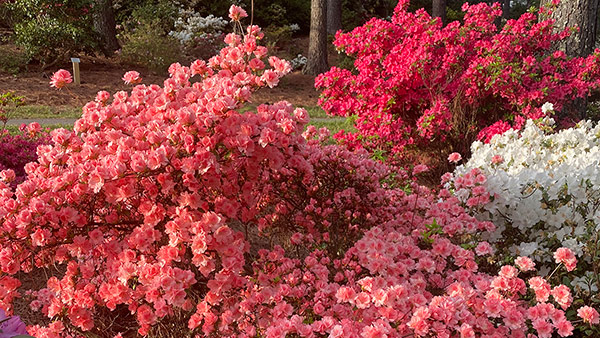
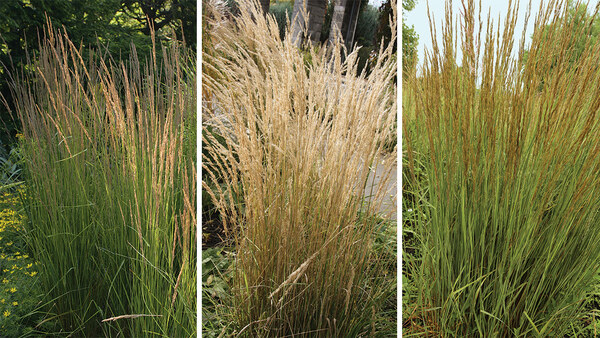

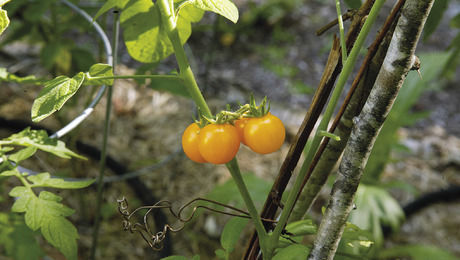












Comments
Log in or create an account to post a comment.
Sign up Log in